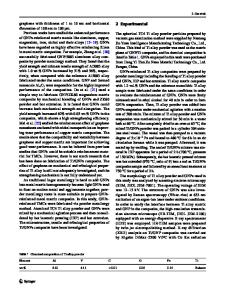The microstructure and mechanical properties of Al2024-SiC p composite fabricated by powder thixoforming
- PDF / 1,031,775 Bytes
- 13 Pages / 584.957 x 782.986 pts Page_size
- 22 Downloads / 355 Views
In this study, SiC particle reinforced Al2024 matrix composites were fabricated by powder thixoforming (PT). Meanwhile, 2024 alloys were fabricated by permanent mold cast (PMC) and PT, respectively, to reveal superiorities of PT technology over the traditional processing technologies and the resulting composite over the matrix alloy. The microstructures and mechanical properties of the three materials were comparatively investigated. The results indicated that both the PT materials possessed finer spheroidal primary particles and smaller eutectic concentration, but the PMC alloy comprised large equiaxed grains, continuously net-shaped eutectic structures, and many porosities. The mechanical properties of the PT alloy were significantly higher than those of the PMC alloy because of the enhanced compactness and work hardening, decreased eutectic concentration, and fine primary particles. The incorporation of SiCp to the PT alloy further brought improvements, the ultimate tensile strength (UTS), yield strength (YS), and hardness were increased by 29.3% (UTS 5 388 MPa), 35% (YS 5 297 MPa), and 46.8% (hardness 5 122.6 HV), respectively. A strengthening model considering different strengthening mechanisms and SiCp failure was proposed and YS of composite could be exactly predicted.
I. INTRODUCTION
Metal matrix composites reinforced with ceramic particles have attracted increasing attention because of their excellent properties, such as high elastic modulus, high specific strength as well as high thermal and electrical properties, having wide applications in automotive, aerospace, military, electronics, and sports industries.1–3 Several processing techniques, such as stir casting (SC), mechanical alloying (MA), and powder metallurgy (PM), have been used for fabrication of metal matrix composites.4–6 Regarding SC method, the introduction of reinforcements to the matrix requires the addition of wetting agents or the reinforcing particles to be coated because of the bad wettability between the matrix melts and reinforcements. Moreover, extensive reactions of reinforcements/matrix interface and the agglomeration of the reinforcements are inevitable. MA method can fabricate the composites with high tensile properties, but long milling time is necessary to obtain homogeneous distribution of reinforcing particles, which excessively increases the work hardening of the milled powders and thus decreases densification ability during consolidation process. PM technology is a well-known commercial process because of the flexible constituent design, Contributing Editor: Jürgen Eckert a) Address all correspondence to this author. e-mail: [email protected] DOI: 10.1557/jmr.2017.95
controllable interface reaction, and homogeneous distribution of reinforcements.7 However, the main challenges of this method are the high processing cost resulting from the complex processes and difficulty in fabricating products with complex shapes and compact microstructures,8 which limit its applications. Therefore, the development of a novel process that not only
Data Loading...











